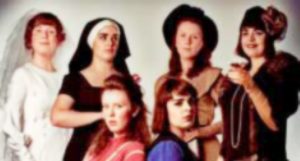Chapel off Chapel, Prahran
Reviewed on September 23, 2012

“Is all that we see or seem but a dream within a dream?” Edgar Allen Poe
Almost 25 years ago, the British playwright, Alan Bennett fashioned a breakthrough series of 12 short plays. Writing for and from the female perspective, Talking Heads allowed its subjects to address the viewer head on. First recorded for television, they were subsequently played on radio, then recreated for the stage.
A double bill, Bed Among the Lentils and Soldiering On, was brought to Australia in 2005 starring Maggie Smith and Margaret Tyzack. We learned what made two ordinary people tick, chances they took or didn’t, and choices they outwardly justified.
Further, U.S. Writer / Director, Rodrigo Garcia, created a powerful and provocative pair of films called Things You Can Tell By Looking At Her and Nine Lives. Both offer brief but telling snapshots into the daily routines of contemporary American women. Characters were captured at their most vulnerable, tested with path – changing decisions at the tipping point.
Two Femmes and a Fatale, is a deliciously tongue – in – cheek homage to forties’ film noir. Hot on its heels, Full Skirted Productions presents a series of six fresh vignettes, part of the Melbourne Fringe Festival, and their own 2011 season. Staged under the one title, The Object of My Affection pushes buttons diverse as the pleasures and pitfalls of 18th century courtship and etiquette, religious doubt in the sisterhood, class conscience, sham marriage, fetishes and child abduction.
Annabel Green and Letitia Kearney share both the writing, directing and performance credits; each actress showcases and explores three separate roles and themes. In turn, Green and Kearney stretch many boundaries traditional monologues will allow, communicating tremendous range with character contrast, costuming, and evolving dialogue. Together, they create a strong connection both with words, gesture and the audience. Meanwhile, the viewer is allowed to eavesdrop on their most private moments. No small detail is left to chance. Indeed, the power of love and its consequences takes on many shapes and forms.
Highlights included Green as a young 18th century upper class bride, demonstrating the poise and presence of a Catherine Tate or a Nicole Kidman. Her character’s initial joy is replaced by grievous concern. Even women in English high society were played and traded like commodities, shackled by the rules of convention. Beneath the surface, we learn she is a highly intelligent individual straight from the pages of a Bronte or Austen novel, trapped by the life chosen for her.
Another role, her saucy Scot with a flair for furniture is a hilarious delight. Worked for laughs with physical aplomb, here Green is Julie Walters and Tracy Ullman wrapped up in one.
Kearney’s three pieces, beautifully rendered, are equally strong. Her post WW1 flapper wife runs the gamut of emotions. Like a character straight out of Stephen Fry’s film, Bright Young Things, she is at turns sexy like Kim Catrall (from Sex and the City) and as she confesses her story, heartbreaking like Lesley Manville (in Another Year). A second study, a sexually frustrated nun’s fall from grace, is played to the comic hilt.
Like the proverbial onion, discussed in detail by Gwen Verdon in Rick McKay’s Broadway: The Golden Age, Green and Kearney allow dialogue to peel away their characters skin in layers. It leaves us with their very essence, or kernel of meaning. There is clear immediacy to Green’s and Kearney’s writing, skilfully establishing each character and their point of view right off the bat. We may not know these characters in daily life, but beneath the uniform, these women on the verge are well worth the journey.
Image Source: Full Skirted Productions
